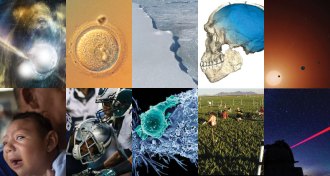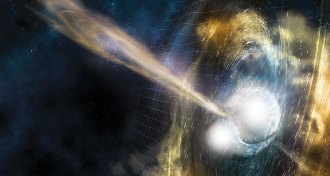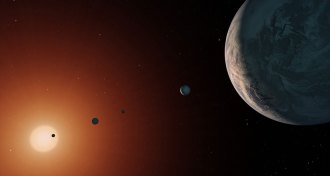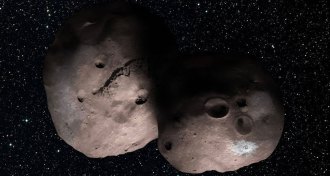Space
Sign up for our newsletter
We summarize the week's scientific breakthroughs every Thursday.
-
 Astronomy
AstronomyThe sun’s outer atmosphere is far more complex than previously thought
The outer corona of the sun was thought to be smooth and uniform. New observations show it’s anything but.
-
 Astronomy
AstronomyOur first interstellar visitor may be a camouflaged comet
Originally thought to be a rocky asteroid, an interstellar traveler may have a comet’s icy heart.
-
 Astronomy
AstronomyAI has found an 8-planet system like ours in Kepler data
An AI spotted an eighth planet circling a distant star, unseating the solar system as the sole record-holder for most known planets.
-
 Planetary Science
Planetary ScienceSaturn’s rings are surprisingly young and may be from shredded moons
Final data from the Cassini spacecraft put a date and a mass on the gas giant’s iconic rings.
-
 Science & Society
Science & SocietyThese are the most-read Science News stories of 2017
From Cassini and eclipses to ladybugs and dolphins, Science News online readers had a wide variety of favorite stories on our website.
-
 Science & Society
Science & Society2017 delivered humility, and proved our potential
Acting Editor in Chief Elizabeth Quill reflects on some of the top scientific stories of 2017.
-
 Astronomy
AstronomyThis year’s neutron star collision unlocks cosmic mysteries
A rare and long-awaited astronomical event united thousands of astronomers in a frenzy of observations.
-
 Astronomy
AstronomySeven Earth-sized planets entered the spotlight this year
The discovery of seven Earth-sized planets orbiting a single cool star fuels a debate over what counts as good news in the search for life outside the solar system.
-
 Astronomy
AstronomyNew Horizons’ next target might have a moon
New Horizons’ next target, Kuiper Belt object MU69, may have a small moon.
-
 Planetary Science
Planetary ScienceJupiter’s massive Great Red Spot is at least 350 kilometers deep
NASA’s Juno spacecraft has measured the depth of Jupiter’s Great Red Spot for the first time.
-
 Earth
EarthWatching this newborn island erode could tell us a lot about Mars
The birth and death of a young volcanic island in the Pacific Ocean may shed light on the origins of volcanoes in Mars’ wetter past.
-
 Planetary Science
Planetary ScienceSaturn’s rings mess with the gas giant’s atmosphere
Data from Cassini’s shallow dives into Saturn’s ionosphere show that this charged layer in the atmosphere interacts with the planet’s rings.